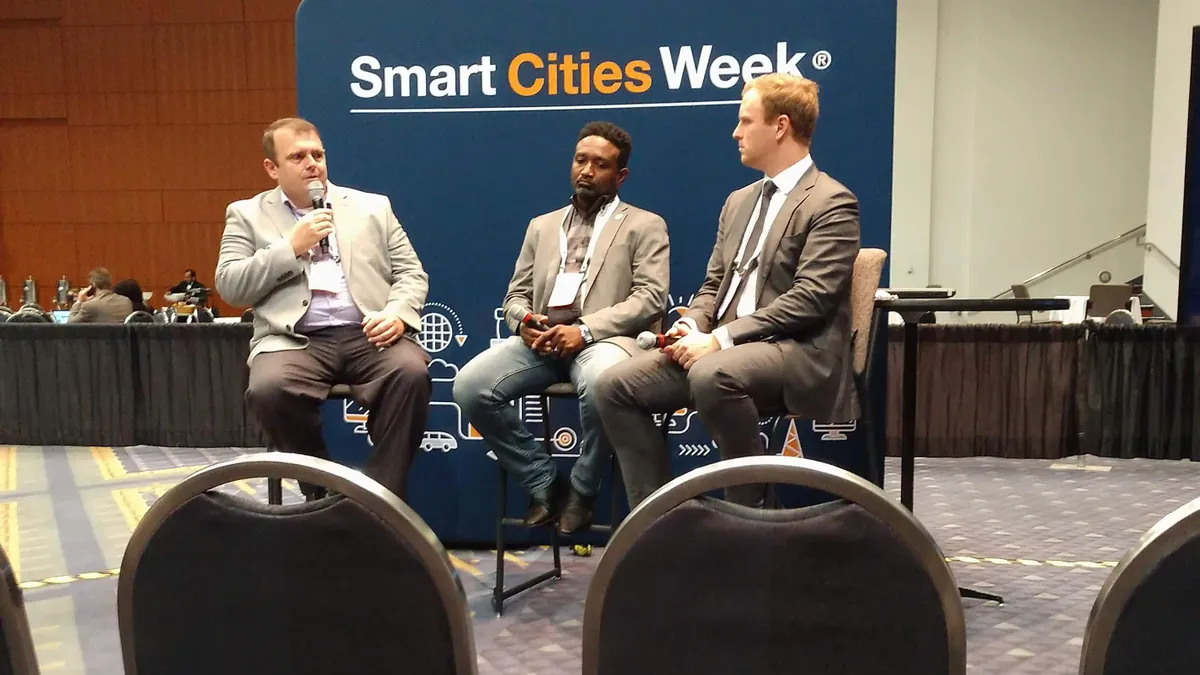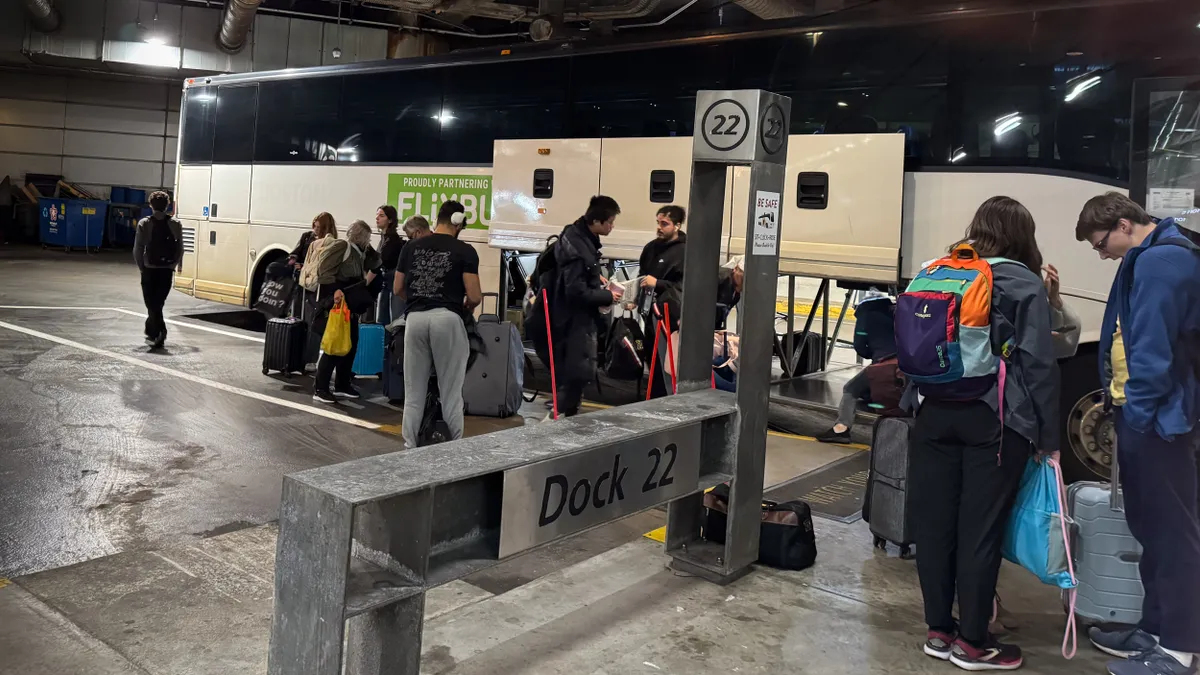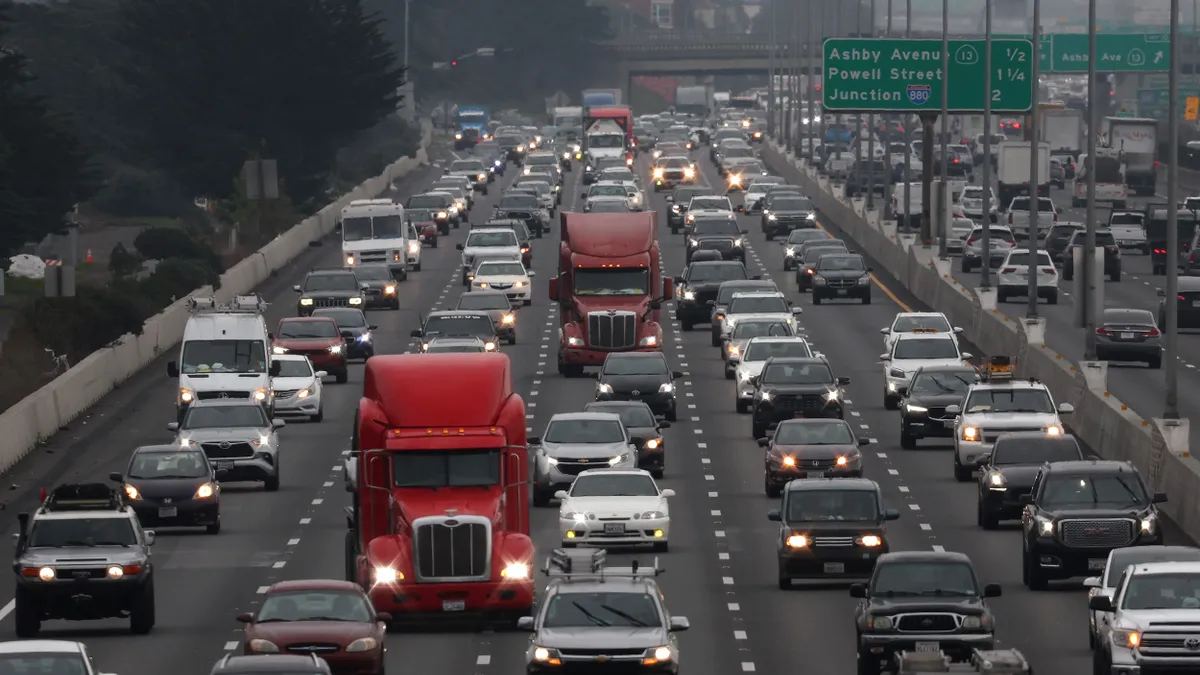On the journey to become a smart city, some consider themselves to be far along, while others may feel they lag.
At Smart Cities Week in Washington, DC, representatives from various municipalities, all in different stages of becoming a smart city, came together at the City Readiness Hub to share ideas, discuss best practices and advise each other.
While everyone acknowledged they still have plenty to learn, and that every journey is far from "complete," several key themes emerged as city leaders reflected on their history and on what is to come.
“At first I looked and thought, we’re so far behind, and we don’t know what we’re doing. But a lot of us, even though some of us are a little further, we're still all in the same place."

Shonte Eldridge
Deputy Chief of Operations, City of Baltimore
Every city is unique
It can be easy to forget that, due to a number of factors such as political considerations or a reluctant citizenry, every municipality will move at its own pace. While some cities may see themselves as being in an arms race with their peers to get smarter, officials warned such thinking is detrimental.
"It's very competitive, they're always interested in knowing what other cities are doing and how they rank," Philip Bane, managing director of the Smart Cities Council, said during a keynote address.
But Bane said that strategy is flawed, as "smart" could be interchangeable for any number of adjectives to describe a city — resilient, for example — so cities shouldn't get too hung up on who is the first truly "smart city." Instead, Bane said, "every city is unique, and that's something we have to understand."
For some, the path to becoming smarter has been part of their DNA for decades. Don Jacobson, Business Partner for Innovation in Information Technologies at the City of Las Vegas, said the city benefits from having buildings and infrastructure that is all 50 years old at most, while the casinos have been considered "smart for 30 years" as they use technology everywhere.
Here's an interesting thought from Don Jacobson, Las Vegas' business partner for innovation in IT: "Casinos have been 'smart' for 30 years." #SmartCitiesWeek
— Chris Teale (@chris_teale) October 3, 2018
That new infrastructure means the city is "connected by default," Jacobson said. That means fiber has been installed for years as standard, while conventions like CES coming to town each year provide ideal opportunities to test new technologies before anyone else.
And with Clark County, NV providing many government services, Jacobson said city dollars are freed up to try something different. "We focus on these kinds of things that are shiny and new,” he said, noting the growth in autonomous shuttles in the city as well as trials from ride-hailing companies Uber and Lyft in using autonomous vehicles (AVs) in the downtown core.
With a spirit of innovation pervading the city, Jacobson said he and his colleagues have “free rein to experiment, conduct pilots in the internet of things (IoT), mobility, public safety" in a "safe sandbox we have to work in."
It is a slightly different story in Baltimore, where Shonte Eldridge, deputy chief of operations for the city, is about four months into leading the city along its smart city journey. "At first I looked and thought, we’re so far behind, and we don’t know what we’re doing,” she said. “But a lot of us, even though some of us are a little further, we're still all in the same place."
Eldridge's first step was to contact businesses, not for money but for advice, on what a smart city is and to broaden her understanding. She said Baltimore needed a solid roadmap based on its needs and the needs of its residents, who suffer from inequity between neighborhoods and poor transit options. She also said while some may view being a smart city as embracing some of the more cutting-edge technology, that won’t quite work in Baltimore, where she still has colleagues adjusting traffic signals by hand.
"Autonomous vehicles? That's great for California. I am nowhere near ready to roll out autonomous vehicles in Baltimore City," she said.
Getting residents on board
Part of the learning curve as a city gets smarter is about educating residents, said Chris Seidt, director of information technology for Louisville, KY.
He noted residents can be distrustful of some technologies such as drones — which the city applied to use as part of its response to gunshots earlier this year — so educating them and allaying any concerns is key in helping move the ball forward.
"You have to do a lot of education for new residents about the technology,” Seidt said. “Most people aren't going to be familiar with these new, emerging things, and there's a learning curve. Sometimes people are scared of new things, so you really have to take the time before you introduce these projects to really engage your residents and educate them about the tech that is being proposed and be willing to listen and adapt and change your project based on their feedback."
Changing the conversation in government
As cities move toward a smarter future, leaders said it is key to make governments think differently, from elected officials on down, and include the planning and procurement processes.
And with this year’s cyberattack on Atlanta still fresh in everyone’s minds, making sure everyone at every city department is up to speed on security procedures remains a top priority.
Both Seidt and Michael Pegues, chief information office at the City of Aurora, IL, said one of the biggest concerns in upping governments’ cybersecurity is making sure employees do not click on phishing emails, which are sent fraudulently pretending to be from reputable companies. Both said those efforts are an ongoing challenge.
"You have to have smart users on your network and they have to be trained for that," Seidt said.
Seidt recalled an incident he described as a "whaling attack," where the city’s open data was used against it by a fraudster. By looking at paid invoices that had been posted online by the city, the attackers created an invoice purporting to be from a vendor, but with one letter changed and detailed instructions on how to wire transfer money.
It was unsuccessful, he said, but raises the question of how much risk a city is prepared to expose itself to. Atlanta, he noted, has incurred upwards of $17 million in damages and recovery costs but had insurance worth much less than that, so taxpayers are on the hook to make up the difference. And there were still losses, including 10 years of police dashcam footage.
"The question you have to ask yourself as an organization is: how much is your risk tolerance?” Seidt asked. “How much are you willing to gamble that that's not going to happen to you?"
Pegues said Aurora has campaigns to reduce the numbers of people clicking on phishing emails, since IT departments and related security initiatives are traditionally underfunded.
"We just have to face it: in the public sector and municipalities, we're never going to get the exact resources we need in the cybersecurity space," he said. Indeed, to convince elected officials to appropriate more money on cyber, Pegues said you must "scare the crap out of them" with tales of cyberattacks. “Never pass up a good crisis,” Seidt agreed.
In general, Eldridge said she has struggled to unify Baltimore’s IT and technology strategy, given the silos across city departments. But, she said, with the support of Mayor Catherine Pugh for her smart city agenda, it is doable. Others, meanwhile, have changed procurement processes so all IT and tech-related requests for proposals are flagged for cities’ office of the chief technology officer or its equivalent.
"The other problem is that right now, tech is not part of the DNA of Baltimore City," Eldridge said. "We have about 30 different departments, and a lot of those departments, the bigger departments like Public Works, [Department of Transportation], Health, they all have their own CIOs, they have their own help desk, and we can't operate like that.”
Planning is key for cities as they try and move things forward, but until relatively recently, that has been difficult. Grace Simrall, Chief of Civic Innovation and Technology with Louisville, said this is the first time technology has been mentioned in the city’s 20-year land use plan, while its most recent transportation plan had a footnote that she paraphrased as saying, "Oh by the way, AVs are coming, and that's the only mention."
That document, which was released in July 2016, was out of date almost immediately. Although Louisville since released an AV playbook, Simrall said it is imperative that government find a way to be agile in its planning documents to take into account new technologies — like dockless bikes and scooters — that come in quickly and disrupt the normal way of doing things.
"I think we need to look at how we put together policy documents that are a bit more agile because emerging technologies are changing at such a rapid pace compared to traditionally planning efforts,” Simrall said.
Helping the vulnerable as automation takes over
While some city leaders may be distracted by what Baltimore’s Chief Information Officer Frank Johnson described as a “rush to the front” to implement new technologies, those in the City Readiness Hub warned closing the digital divide is key on the path to being smart.
"You can see the snowball of smart cities and it's a great thing, so long as you don't get run over by it,” David Herlihy, division chief for technology and innovation at Arlington County, VA, said.
One way to do that has been through leveraging municipal fiber initiatives, where the fiber is laid first to connect municipal buildings, schools and others like hospitals and prisons, then private companies are able to get involved and connect businesses and homes.
Herlihy said Arlington’s fiber network has been in the ground for five years now, and is being leveraged for digital equity, with pilot projects wiring up 270 units in affordable housing complexes to give their residents high-speed internet under a three-year pilot.
And the fiber provides other opportunities for the county, including better connecting its hospital and detention center for telemedicine, meaning inmates suffering medical issues can be examined online rather than be transported for an in-person examination, saving the county money on transportation costs in a tight budget.
"With these type of problems, we look at it as opportunities on the IT side,” Herlihy said. “Where can the technology and ConnectArlington bridge these divides and continue to answer to our [County] Board and to our residents?"
Simrall said it is a similar story in Louisville, which is in the process of constructing 115 miles of its municipal fiber network, in addition to the 21 miles it already has in its central business district right now.
That came as an offshoot of the Kentucky Wired initiative, which looks to build out more than 3,000 miles of fiber to all 120 counties. The initiative focuses on the rural parts of the state, but also allows cities such as Louisville to piggy-back while not incurring much of the construction and engineering costs.
The initiative, which has been criticized for cost overruns and delays, also came in for opposition from the cable industry and its trade groups that warned that government should not be doing something so "risky or too innovative," Simrall said.
Traditional jobs may also be vulnerable to automation through the likes of artificial intelligence (AI) and machine learning. Jacobson said Las Vegas is “ripe for automation” and has already taken steps in its service industry with robots than can make the perfect cocktail, while iPads can take food orders and casinos use facial recognition technology to check-in guests.
"All that is becoming automated faster than we can prepare people,” Jacobson said. “Then they go, 'Well, I'll just become an Uber or Lyft driver.' Guess what, we're automating that as well."
To prepare them, Jacobson said the city has created a youth development and social innovation department to help educate future generations and ensure they "have the skill set necessary to live and thrive in Las Vegas in 2050."
Automation could leave city residents feeling left out, and the National League of Cities (NLC) called on municipalities to take “strategic steps” to avoid that. Recommendations included refining educational offerings and making sure young people truly understand how they can make new technology work for them. Eldridge echoed that view.
“Everybody's like, 'AI is coming, AI is coming,'” she said. “Yes, there is going to be some job loss because that's just the natural cycle of the world, we have new technology ... We need to make sure we can educate the new generations to actually make sure they have the skills for the jobs that are coming.”




















